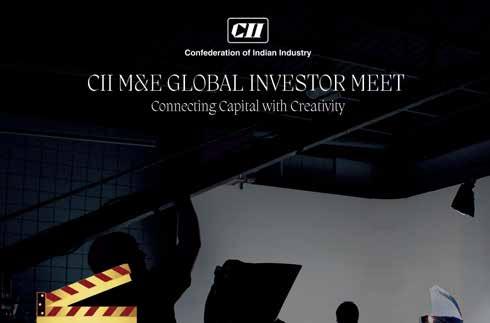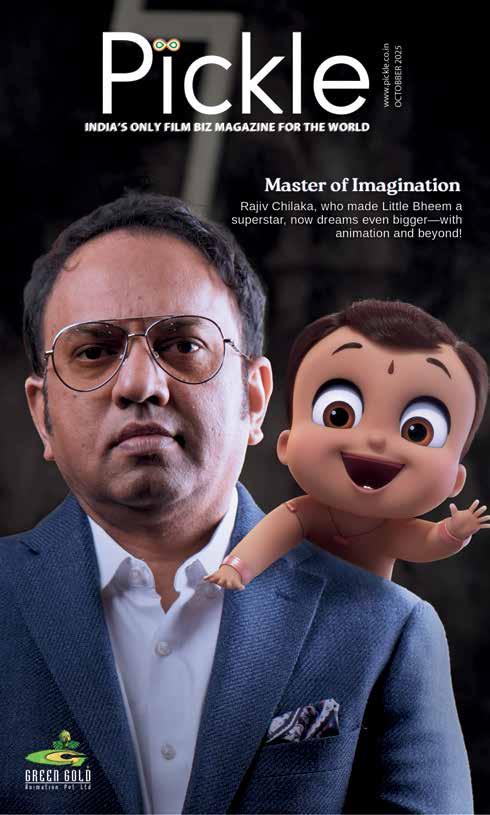
Where deals are done, partnerships are born, and stories find their stage.

13th-16th October
Palais des Festivals, Cannes.


Where deals are done, partnerships are born, and stories find their stage.

13th-16th October
Palais des Festivals, Cannes.
India has rapidly established itself as a key player in the global audiovisual sector, attracting interest and investment from companies around the world. The country has consistently championed the vision of “Design in India, Design for the World,” driving innovation and positioning itself at the forefront of this rapidly evolving industry.
A significant milestone in this journey is the establishment of the Indian Institute of Creative Technology (IICT). This initiative is designed to foster a dynamic ecosystem for the AVGC-XR (Animation, Visual Effects, Gaming, Comic, and Extended Reality) industries, which have become the backbone of the audiovisual sector. IICT aims to nurture talent, encourage global collaborations, and support the creation of cutting-edge content and technology.
India’s expanding leadership in Artificial Intelligence (AI), combined with strong technical expertise, is accelerating the evolution of AVGC-XR and laying a solid foundation for future growth. Success stories like “Narasimha” and “Kantara Chapter,” along with significant events such as the UK Prime Minister’s visit to Mumbai, have fueled optimism across the industry.
Recognizing this momentum, nearly a dozen Indian states are actively formulating policies to support sector expansion. Major platforms—such as the WAVES Summit
and other key events in 2025 (CII Big Picture Summit, Global Investor Meet, IndiaJoy, IGDC, IFFI, and WAVES Film Bazaar)—are set to showcase Indian talent and innovation to a global audience.
A special highlight this year is the Bharat Pavilion at MIPCOM 2025, organized by the Ministry of Information, which will feature content for sale and co-production initiatives. With over 100 Indian companies and studios and more than 200 delegates participating, India’s footprint at MIPCOM continues to grow.
In this special MIPCOM 2025 edition of Pickle, we are excited to present the latest trends, insights, and opportunities in the media and entertainment (M&E) sector, including exclusive interviews with industry leaders like Manoj Mishra of Green Gold and several other thought leaders.
MIPCOM stands as one of the world’s premier media events—an essential forum for networking, discovering emerging trends, and building partnerships that will define the future of the industry. For executives seeking to stay ahead in a rapidly changing market, it is a must-attend

For any queries, please contact us. Stay tuned for the latest from India’s dynamic M&E industry.
n vidyasagar
pickle media nat@pickle.co.in, www.pickle.co.in
Pickle Volume XVIII 5th Edition
Published by Pickle Media Private Limited
Email: natvid@gmail.com l Mumbai l Chennai No.2, Habib Complex Dr Durgabhai Deshmukh Road RA Puram CHENNAI 600 028
For advertising: natvid@gmail.com / pickle@pickle.co.in
Senior Editor : Vivek Ratnakar
Editorial Coordinators : Maitreyi Vidyasagar, Shruti Sundaranand
Design: Jose J Reegan, James, D Sharma, S Lakshmanan
Photo Editor : K K Laskar
Admin & Operations : B Rajalakshmi
Email: natvid@gmail.com
Pickle Business Guide 2025 Copyright 2025 by Pickle Media Pvt Ltd. All Rights Reserved. Pickle is an ad supported business guide tracking the filmed entertainment business in India.













What started as an initiative to unify India’s Film, Animation, Visual Effects, Gaming, Comics and XR (AVGC-XR) sectors has transformed into India’s largest digital entertainment festival — endorsed by the Government of Telangana and powered by the IndianFilm, AVGC-XR ecosystem.







30,000+ Visitors










200+ Exhibitors
Sri. D. Sridhar Babu
“The Indian VFX, Animation & Gaming Industry is at a very interesting and crucial juncture. With endless possibilities, the future will be demanding and very fruitful. The Govt of Telangana supports the local talent and soft power through IndiaJoy.” Indiajoy








SOUTH ASIA’S
SOUTH ASIA’S
SOUTH ASIA’S
SOUTH ASIA’S
TOP FILM MARKET FOR
TOP FILM MARKET FOR
TOP FILM MARKET FOR
TOP FILM MARKET FOR
TOP FILM MARKET FOR SOUTH ASIA’S
GLOBAL COLLABORATIONS & CO-PRODUCTION
GLOBAL COLLABORATIONS & CO-PRODUCTION
GLOBAL COLLABORATIONS & CO-PRODUCTION
GLOBAL COLLABORATIONS & CO-PRODUCTION
GLOBAL COLLABORATIONS & CO-PRODUCTION
20-24 November, 2025 | At Marriott, Panjim, Goa
20-24 November, 2025 | At Marriott, Panjim, Goa
20-24 November, 2025 | At Marriott, Panjim, Goa
20-24 November, 2025 | At Marriott, Panjim, Goa
20-24 November, 2025 | At Marriott, Panjim, Goa
Main verticals
Main verticals
Main verticals
Main verticals
Main verticals
CO PRODUCTION MARKET
CO PRODUCTION MARKET SCREENWRITERS’ LAB
CO PRODUCTION MARKET SCREENWRITERS’ LAB WORK IN PROGRESS LAB
SCREENWRITERS’ LAB WORK IN PROGRESS LAB
CO PRODUCTION MARKET SCREENWRITERS’ LAB WORK IN PROGRESS LAB
WORK IN PROGRESS LAB
CO PRODUCTION MARKET SCREENWRITERS’ LAB WORK IN PROGRESS LAB
VIEWING ROOM
VIEWING ROOM
VIEWING ROOM
It is a converging point for South Asian & international film makers & film producers, sales agents & festival programmers for potential creative & financial collaboration






November 20-28,2025 | Goa, India






















The
LOS ANGELES I NOVEMBER 11-16, 2025

Government-backed WAVES Bazaar aims to spotlight the country’s creative diversity and foster new global partnerships. Supported by a high-level government delegation, the initiative will connect Indian media, entertainment, and technology sectors with international buyers, investors, and collaborators in Cannes
India is set to take center stage at MIPCOM 2025 in Cannes, as the country’s flagship creative economy platform, WAVES Bazaar, prepares to exhibit for the first time at the world’s leading international television and streaming content market. This milestone marks a significant step for India’s media and entertainment industry as it expands its global outreach and seeks to forge new partnerships across the international creative economy.
Bridging India’s Creative Industries with the World
WAVES Bazaar, launched earlier this year as part of the inaugural WAVES Summit in India, is a dynamic online platform and year-round summit designed to connect creators, investors, and businesses across the entertainment sector—including film, TV, animation,
videogames, music, immersive media, and more. With its entry into MIPCOM, WAVES Bazaar aims to position itself as the primary bridge between India’s burgeoning creative industries and global markets, particularly in Europe.
The first WAVES Summit in May 2025 drew an impressive 6,000 sellers and 7,000 buyers, showcasing 2,500 projects and generating nearly €13 million in business. Since then, the platform has rapidly expanded its reach, holding editions at major international events including the Toronto and Busan Film Festivals, Gamescom, Tokyo Game Show, and IberSeries in Madrid. These global initiatives have established WAVES Bazaar as a go-to destination for investments, collaborations, policy discussions, and B2B meetings across the media and entertainment spectrum.
A high-profile delegation from the Indian Consulate General in Marseille will be present in Cannes to champion the WAVES initiative, underlining the Indian government’s commitment to supporting the country’s global creative economy ambitions.
The delegation will include Niraj Kumar, Director of TV Broadcasting at the Indian Ministry of Information and Broadcasting, and Vikram Singh Malik, Director of WAVES OTT under Prasar Bharti, India’s public service broadcaster.
“We are extremely pleased to be attending MIPCOM to launch WAVES Bazaar as the bridge between India’s media and entertainment sector and global markets, particularly in Europe,” said Kumar.
“Our aim is to show India’s creative diversity across television, films, animation, gaming, music, and immersive media. Our focus here in Cannes is to develop deals, partnerships, and investments by sharing India’s creative vision with companies looking to collaborate across multiple sectors.”
Malik added, “We see WAVES Bazaar as a gateway to strong partnerships. Attending MIPCOM for the first time will allow us to directly engage with creatives from around the world. As well as helping Indian creators seeking to expand into Europe and beyond, WAVES Bazaar offers global companies easy access to connect across all sectors, particularly in areas of innovation, technology, and India’s exceptional capabilities in VFX, AR/VR, AI, and post-production services.”
WAVES Bazaar’s scope is far-reaching, actively supporting the entire spectrum
of the entertainment industry. The platform facilitates opportunities and partnerships in live action, animation, gaming and esports, music and sound, VFX, comics, e-books, radio, podcasts, XR/VR/AR, immersive experiences, and live events. Its hybrid approach—combining digital platform access with on-ground networking at major international events—has drawn immense interest from stakeholders worldwide.
Every October, MIPCOM transforms Cannes’ iconic Croisette into the beating heart of the global content industry, bringing together executives and creatives from over 100 countries. The 2025 edition is set to introduce new initiatives targeting the Creator Economy, further opening avenues for dealmaking among digital creators, television producers, distributors, and brands.
India’s participation through WAVES Bazaar aligns perfectly with MIPCOM’s renewed focus on innovation and crossindustry collaboration. As the world’s content landscape continues to evolve, India’s creative economy is poised to play a pivotal role in shaping the future of global entertainment.
With a strong government mandate, proven success at home, and a clear vision for international expansion, WAVES Bazaar’s debut at MIPCOM marks a new chapter for India’s media and entertainment sector. As the pavilion opens its doors in Cannes, all eyes will be on the partnerships, deals, and creative exchanges that will emerge— signalling India’s growing influence on the world entertainment stage.
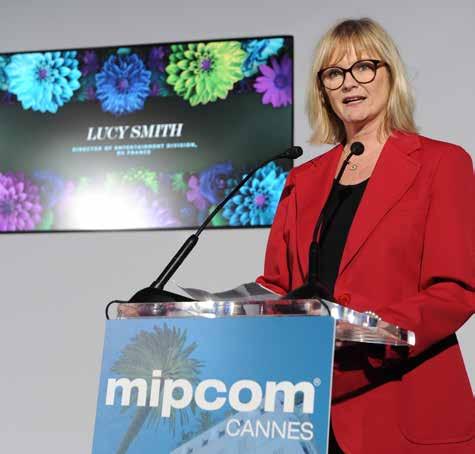
AT MIPCOM 2025, WE’RE BRIDGING THE CREATOR ECONOMY WITH MAINSTREAM MEDIA, FOSTERING COLLABORATION AROUND INNOVATIVE MONETIZATION STRATEGIES, NEW DISTRIBUTION MODELS, AND TRANSFORMATIVE INDUSTRY PARTNERSHIPS THAT DEFINE THE FUTURE OF CONTENT
Lucy Smith, Director of the Entertainment Division of RX France
As MIPCOM CANNES 2025 returns to the Palais, more than 10,500 industry power players will gather to explore the future of content creation, distribution, and innovation—where streaming giants, creators, and brands shape the next chapter of global entertainment
MIPCOM CANNES 2025 will be more than just a market when the world’s top television and streaming companies meet in Cannes this October (13-16). It will also show where the global content industry is going.
The event, which will take place at the Palais des Festivals from October 13 to 16, 2025, is expected to have more than 10,500 delegates from more than 100 countries. This is the 41st time it has happened. This year’s main theme, “The Creator Economy,” points to a future where television, technology, and stories told by creators come together more and more.
Keith Le Goy, Chairman of Sony Pictures Television, will be the keynote speaker this year. He will open MIPCOM on October 13 with a fireside chat as part of the “C Suite Conversations” series in partnership with Variety.
Le Goy has changed the way content moves over the course of his 20 years at Sony. He has overseen the company’s television production and home entertainment businesses and negotiated landmark distribution deals with Netflix and Disney.
Lucy Smith, the Director of MIPCOM CANNES, says his keynote speech, will look at how the balance between global IP, streaming strategy, and creative collaboration is changing, sets the tone for an edition that is likely to change how partnerships work across platforms.
Sony Pictures Television will show “The Miniature Wife,” a dramedy based on Manuel Gonzales’ short story, on the first day of the event.
It shows how MIPCOM is becoming a more important place for launching high-quality content around the world.
The Creator Economy Is the Main Event
YouTube, TikTok, and Dhar Mann Studios will be the main speakers at MIPCOM for the first time. They will talk about the Creator Economy, which is where making content, getting people involved, and making money all come together.
YouTube is celebrating its 20th birthday by having its biggest presence ever at
MIPCOM. It opened the YouTube Space in the Palais des Festivals and hosted a keynote speech by Pedro Pina (VP, YouTube EMEA) and Jasmine Dawson (YouTube Originals).
The creator partnerships team at YouTube will lead workshops that look at how digital-first storytelling is changing the future of TV.
Shira Lazar will host a session with creators like Callum “Callux” McGinley, Ben Doyle, Dhar Mann, and Kudzi Chimkubu to talk about next-generation storytelling. Lea Karam will lead a datadriven look at audience habits using information from Snapchat and Twitch.
New places to work together
MIPCOM this year has a lot of new formats that are meant to speed up partnerships and co-productions.
At the MIP CREATIVE HUB on the beach in Cannes, creators and producers from Amazon Studios, BBC, Banijay Entertainment, After Party Studios, and Arsenal Fan TV will meet in planned sessions that mix coming up with ideas and making deals.
At the same time, the MIP INNOVATION LAB, which is in the basement of the Palais, will show off how AI, AVOD, and FAST channels can work together.
Ceyda Sila Cetinkaya and Tarif Rahman will lead workshops on how to use technology to get more people interested, and Adrienne Lahens will give a keynote speech on “Storytelling in the Imagination Age.”
This lab, which is backed by Kling AI and Vimeo, sees technology not as a disruptor but as a creative partner.
BrandStorytelling is coming to Cannes MIPCOM and BrandStorytelling, the U.S.-based group that put on the famous Sundance Summit, are teaming up to host the first-ever international BrandStorytelling Summit. The event will take place from October 13 to 16 and will bring together marketers, producers, and storytellers from around the world to talk about brand-funded programming as a new type of entertainment.
IPG Mediabrands Entertainment Spain is the first sponsor of the summit, and

the first group of speakers comes from Banijay Entertainment, BBC StoryWorks, Toys“R”Us, and UTA.
Unmissable Premieres: Stories That Go MIPCOM CANNES keeps impressing with exclusive screenings and world premieres, in addition to keynotes and strategy sessions.
On October 12, Paramount Global will show “Boston Blue,” a new CBS drama that takes place in the same world as “Blue Bloods.” Sonequa Martin-Green stars in the show, and Donnie Wahlberg returns to his famous role as Detective Danny Reagan, who is now based in Boston. International buyers will get a sneak peek at the series before it airs on CBS on October 17.
The screening will be followed by a Q&A with Wahlberg and Martin-Green.
The next day, people will be talking about Sony’s The Miniature Wife. On October 14, German powerhouse UFA Fiction will show the world premiere of “Ku’damm 77,” the next chapter in Annette Hess’s popular family saga. The Schöllack family’s dance school in Berlin in the 1970s is the setting for the series, which looks at generational conflict and freedom.
The Evolution of Mattel’s Storytelling
Robbie Brenner (President of Mattel Studios) and Josh Silverman (Chief Franchise Officer of Mattel) will give a joint keynote speech about how the company’s storytelling legacy is changing in the age of franchises.
Their session will explain how brands can stay culturally relevant while growing across formats, from Barbie’s worldwide success to upcoming live-action projects like Masters of the Universe and Matchbox.
New MIPJUNIOR:
Before the main event starts, MIPJUNIOR (October 11-12) will be back at the Debussy Theatre and Gare Maritime with a new format that includes better matchmaking sessions and exclusive content showcases.
Andy Yeatman, a leader in children’s entertainment, will give the keynote speech on cross-distribution of IP. He will be joined by speakers from the BBC, Viral Nation, and research presentations from Glance and Omdia. The K-Animation Global Showcase is one of the best things about this year. It shows how quickly Korea is becoming a major player in kids’ and family programming.
As MIPCOM CANNES 2025 takes place in the Palais and on the Croisette, it’s clear that this year’s event goes beyond the usual media boundaries. It’s a place where creators, executives, brands, storytellers, and technology all come together.
MIPCOM is becoming the centre of the modern entertainment ecosystem. Or as Lucy Smith says, “In 2025, the business of television isn’t just about what’s on screen; it’s also about who’s making it, how it’s funded, and where those stories go next.”
THOUGHT LEADER INSIGHTS FOR NEXT-GENERATION STORYTELLING AND TECHNOLOGICAL BREAKTHROUGHS







As global eyes turn to Mumbai, the CII M&E Global Investor Meet (December 1, 2) , as part of the 12th Edition of CII BIG PICTURE SUMMIT promises not just deals, but a front-row seat to the future of entertainment—where innovation and investment converge on the world’s biggest stage
Get an insider’s view of one of the world’s fastest-growing media and entertainment industries, projected to hit $100 billion by 2030.
Preview a curated slate of high-potential projects across films, VFX, Web Series gaming, AI, theme parks and established companies looking for collaboration and divestment—many seeking investments between $1 million and $100 million.
Benefit from one-on-one meetings with pre-vetted companies, ensuring focused discussions and faster deal closures with decision-makers.
Leverage India’s 17 international co-production treaties for seamless global partnerships and market expansion.
Take advantage of production costs 30–40% lower than global benchmarks and government incentives up to $3.6 million for key creative sectors.
Explore opportunities in tech-driven segments like AI, immersive experiences, and gaming— India’s fastest-growing creative sectors.
8 10 5 7 9 6
Connect with a diverse investor pool—VCs, PEs, film funds, HNIs, and accelerators—plus major studios and innovative startups.
Gain valuable market intelligence and trend briefings from leading industry specialists to help guide smart investment decisions.
Participate in exclusive site visits to Mumbai, Delhi, Bengaluru, and Chennai, witnessing firsthand the scale and capability of India’s studio ecosystem.
Be among the first to discover and back the next wave of Indian and global entertainment hits, positioning yourself at the forefront of industry trends.
� Invest in India-specific opportunities across Digital Media, Broadcasting, Print, Online gaming, Filmed entertainment, Animation & VFX, Theme Parks, Live Events, Music and audio.
� Meet the right decision-makers — promoters, founders, C-suite leaders, and senior government officials driving the industry forward.
� Gain direct access to funding sources through private, curated meetings designed to speed up growth and expand global reach.
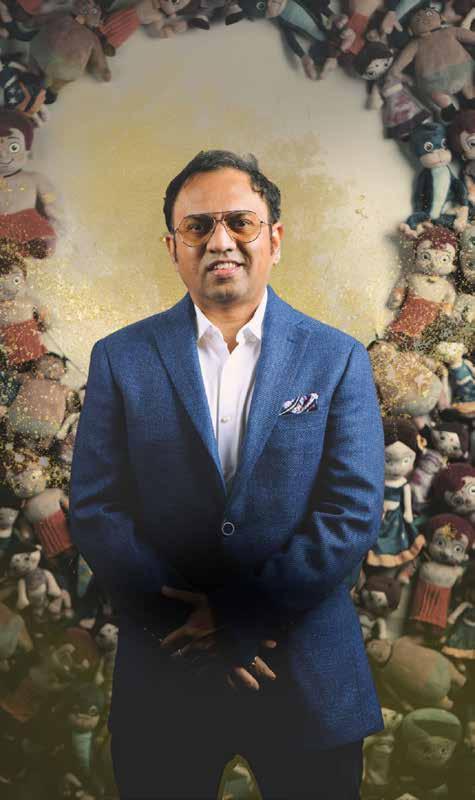
INDIA’S ANIMATION INDUSTRY IS AT A TURNING POINT. WE NEED TO CREATE WORLD-CLASS STORIES AND SCALE OUR INFRASTRUCTURE. GLOBAL EVENTS LIKE MIPCOM HELP US ANTICIPATE TRENDS, FORM PARTNERSHIPS, AND STAY INSPIRED—SO WE CAN BUILD BRANDS THAT RESONATE WORLDWIDE
RAJIV CHILAKA
CEO OF GREEN GOLD ANIMATION Studio President, TVAGA (Gaming & Animation) Co-Founder and President of IndiaJoy
The Chhota Bheem Café is more than a brand extension—it’s a bold leap in experiential brandbuilding, blending nostalgia, family entertainment, and the food business. As Rajiv Chilaka, CEO of Green Gold Animation, innovate beyond the screen, his vision echoes the spirit of MIPCOM: reimagining content and consumer engagement for a global stage. It’s a signal that Indian creativity is ready to influence the world, one experience at a time. Rajiv Chilaka chats with Pickle
Few names are as synonymous with Indian animation as Rajiv Chilaka, the visionary founder and CEO of Green Gold Animation. Over nearly two decades, Chilaka has transformed a simple idea into a cultural phenomenon, bringing homegrown characters like Chhota Bheem into millions of households and establishing Green Gold as a powerhouse in original children’s content. But as the media landscape rapidly evolves—with new technologies, changing audience tastes, and shifting business models—Chilaka is steering his studio into uncharted territory. In this exclusive conversation with Pickle for our MIPCOM edition, Rajiv Chilaka opens up about Green Gold’s ambitious new directions, including bold forays into teen and family animation, live-action, and experiential spaces such as the recently announced Chhota Bheem Cafés. Reflecting the very spirit of MIPCOM—where global leaders gather to set new benchmarks for content and audience engagement— Chilaka’s strategy showcases how Indian IP can innovate, collaborate, and create memorable experiences both on and beyond the screen. In a marketplace where brand engagement is increasingly about emotional connection and memorable moments, the café model stands as a creative blueprint for Indian IP owners eyeing new revenue streams and deeper audience loyalty. If successful, it could inspire a wave of similar cross-industry collaborations, turning fictional worlds into everyday destinations. As Indian consumers seek out unique experiences and as the lines between entertainment, retail, and hospitality blur, initiatives like the Chhota Bheem Café might just signal the next big chapter for homegrown animation brands—and for how we all experience our favorite stories. The Green Gold CEO discusses the opportunities and challenges of building enduring brands in the era of AI and OTT, shares candid insights about the future of Indian IP, and reveals why now is the time to think bigger than ever before.
Green Gold Animation has been synonymous with kids’ entertainment in India for nearly two decades. As you look to the next decade, how do you see the company evolving?
Rajiv Chilaka: So far, our focus has been almost entirely on animation for kids—mostly preschool content (2-6) and shows for the 4-to-8 or 8-to-12 age group. Sometimes, we’ve stretched to an 8-to-13 audience, but never really beyond that. Now, as we look ahead, our big shift is towards teen content. We’re planning a lot of animation targeting that 13-to-19, even up to 24, age bracket—much like how anime caters to teens and young adults. While anime is traditionally 2D, we’ll explore both 2D and 3D formats, and the aim is to create content that appeals not just in India, but also internationally.
That’s a significant shift. What prompted this decision to expand your horizons?
Rajiv Chilaka: The landscape is changing. We’ve built a strong foundation for Indian animation— studios, directors, writers, the whole ecosystem. Theatrical animated films are finally gaining traction here, not just for kids but with wider audiences, as seen in China, Indonesia, Malaysia, and even India recently. With the success of films like “Narasimha,” the door has really opened. When the right content is shown, people will come, regardless of the medium. We feel the industry is ready to go beyond its traditional boundaries, and we want to lead that charge.
Apart from animation, are there other areas Green Gold is exploring?
Rajiv Chilaka: Absolutely. We’re diversifying into visual effects and liveaction as well. We’re also in the market to raise funds, as we want to accelerate our growth over the next five years—maybe even look at an IPO. This diversification not only strengthens us as a company

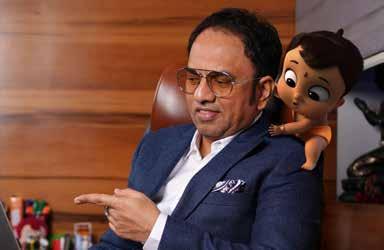
� Rajiv Chilaka is the founder and CEO of Green Gold Animation, the studio behind India’s most beloved homegrown characters, including Chhota Bheem and Mighty Little Bheem.
� Widely recognized as India’s most successful original IP creator, Chilaka transformed a modest idea into a billion-rupee empire, making Indian animation a global force.
� Inspired by Walt Disney, Chilaka launched Green Gold in 2001, at a time when Indian animation was dominated by outsourcing and lacked original content.
� He dared to dream differently—crafting Indian stories with universal appeal. His breakout hit, Chhota Bheem, debuted in 2008 and quickly became a household name, now boasting hundreds of episodes, movies, and a business footprint spanning merchandise, apps, and even cafés.
� Chilaka’s vision didn’t stop at Indian borders. Mighty Little Bheem, a nonverbal Netflix original, became a global preschool phenomenon, streaming in 190 countries and proving Indian stories can win hearts worldwide.
� His unwavering belief in owning and nurturing intellectual property has kept Green Gold at the forefront, collaborating with giants like Disney, Netflix, and Warner Bros.
� Beyond animation, Chilaka is the co-founder of TVAGA & IndiaJoy, and president of TVAGA, continually pushing for innovation and industry growth.
WE’RE GOING BEYOND KIDS’ CONTENT. OUR NEXT CHAPTER IS ABOUT ANIMATION FOR TEENS AND YOUNG ADULTS, EXPLORING BOTH 2D AND 3D FORMATS TO APPEAL NOT JUST IN INDIA, BUT INTERNATIONALLY. THE INDUSTRY IS READY, AND WE WANT TO LEAD THAT CHARGE
but also prepares us for the changes ahead in the industry.
What kind of changes do you foresee, especially with the rise of AI in animation?
Rajiv Chilaka: AI is already starting to impact our field, and its influence will only grow. Today, maybe 10–15% of animation production leverages AI, but as the technology evolves, that could shoot up to 80%. If that happens, networks may not need large studios like ours anymore. They could have a handful of people and an AI-powered system to generate content from scripts. The traditional studio model will need to adapt accordingly. Our response is to focus on monetizing our content directly—through theatrical films, licensing, merchandising, and by building evergreen brands.
How important is IP (intellectual property) ownership in this new era?
Rajiv Chilaka: It’s crucial. If you own an IP, you need to activate it. Just owning it but doing nothing doesn’t help. You have to work on licensing, merchandising, and creating ancillary revenue streams— like we’ve done with Chhota Bheem. If you don’t keep your brand active and relevant, it won’t survive the test of time. In India, a lot of animated IPs have come and gone. The ones that lasted—like Bheem or Motu Patlu—are those that have stayed relevant for over Seven plus years. That’s when you know you’ve built a brand.
Are there global examples you look up to in terms of brand longevity?
Rajiv Chilaka: Absolutely. Look at Hello Kitty or Mickey Mouse. Hello Kitty earned $4 billion last year, and Mickey Mouse wasn’t far behind. There’s no new Mickey Mouse movie or TV show topping the charts, but it’s an instantly recognizable brand worldwide. That’s the kind of legacy we want for Bheem and our other properties. Over 17 years, Bheem has become a household name across India and even parts of Asia. That’s the kind of enduring relevance we aim for.
You’ve recently announced the launch of Chhota Bheem Cafés. Tell us about that initiative.
Rajiv Chilaka: We see cafés as a great way to expand the brand’s footprint. Our short-term plan is to open two pilot cafés in Hyderabad—we chose Hyderabad because we have our roots here, and our F&B partner, ABG Group, is based here too. The idea is to roll out 50 cafés every year, eventually operating on a franchise model to ensure rapid expansion. Cafés offer more than merchandise stores ever could—they create an experience around our characters and bring families closer to the brand. Down the line, we’d love to build experience centers and, eventually, even theme parks.
Do you see a growing demand for such experiential entertainment in India?
Rajiv Chilaka: Definitely. Today, families face traffic and time constraints; most outings are to malls, restaurants, or movie theaters, which don’t always offer real value for kids. Entertainment zones
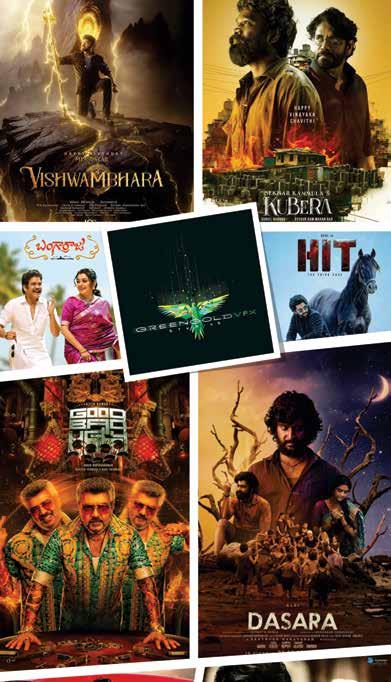
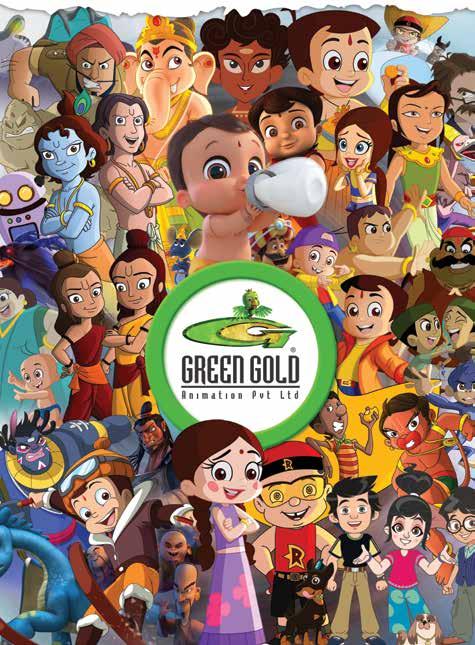
with physical and mental engagement— where kids can learn and play—are the need of the hour. That’s where our concept fits in, and the timing feels right.
The industry is facing economic headwinds. How do you motivate your team and yourself as a leader during tough times?
Rajiv Chilaka: There’s a bit of panic in the market globally—things have slowed down everywhere. But I believe that, just as India has taken leadership in other industries, we should aim to do the same in animation. The key is to produce content for global audiences, not just Indian ones. Collaboration will be crucial. Just look at Japanese anime— they succeeded because they expanded beyond the kids’ market and created franchises that resonate with all ages. A 14-year-old who loves a film can share that excitement with the world in a way a 4-year-old cannot. We must keep that in mind and make universally appealing stories.
“Narasimha” attracted a broad demographic. Tell us about that experience.
Rajiv Chilaka: The success of “Narasimha” was a revelation. When I finally saw it in theaters, it was a latenight show, mostly adults—ages 25 to 40, even grandparents. Only two or three kids in the audience! It proved that if you give audiences great content, they’ll come, regardless of the medium. The same is true for South Indian films that have found pan-India success—it all comes down to the quality of the story.
Given the challenges with TV and OTT platforms, how are you thinking about distribution?
Rajiv Chilaka: TV is fading in developed markets and even in India, its days may be numbered. TV channels are struggling, OTTs focus on content that draws paying subscribers, and kids can’t pay. That’s why we’re pivoting to teen and young
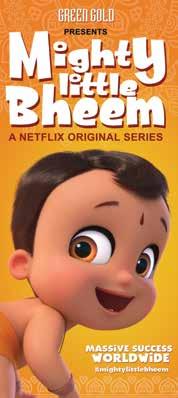
adult content. It’s about staying relevant as consumption habits shift.
Do you think the adult audience for animation in India exists because they grew up watching it?
Rajiv Chilaka: That’s part of it, but not the whole story. Audiences now want variety. They’re tired of the same actors, the same tropes, and are looking for fresh stories and new perspectives. That’s why films with unique stories or deep-rooted

AI IN ANIMATION IS ALREADY HERE—AND IT’S ONLY GOING TO GROW. WE HAVE TO ADAPT BY BUILDING EVERGREEN BRANDS AND DIVERSIFYING
cultural connections—like “Kantara”— resonate. The pandemic also made people value family and culture more. Indian philosophy and values are being celebrated, and there’s a global appetite for authentic stories.
How critical is it to keep evolving stories—even for established brands like Bheem?
Rajiv Chilaka: Familiarity helps, but it’s not enough. The content has to evolve with the audience. If the story doesn’t connect or excite, people will drift away. That’s why we keep reinventing Bheem, creating new seasons and formats, and are in talks with Netflix for fresh content. It’s about staying relevant and meeting the audience where they are.
What’s your vision for the Indian animation industry in the coming years?
Rajiv Chilaka: I think the next few years are pivotal. India needs to scale its screen infrastructure, create content that can stand alongside the world’s best, and focus on quality over quantity. If we make more world-class films, the infrastructure will catch up naturally. My hope is that we continue to experiment, collaborate, and tell stories that matter— both for India and for global audiences.
How important are global industry events like MIPCOM for Green Gold Animation’s strategy and staying ahead of market trends?
Rajiv Chilaka: Events like MIPCOM are absolutely vital for us. They serve as a barometer for the industry’s mood and direction. Last year, for instance, at MIPCOM, it was clear that the market was bracing for a slowdown—people were telling us to check back in several months, rather than immediately. That kind of feedback helps us anticipate market trends and plan accordingly. These events are also a fantastic platform for networking, forming new partnerships, and understanding what global buyers and audiences are seeking. Especially in tough times, only the most resilient companies thrive, and these markets become crucial for forging alliances and discovering fresh opportunities. For us, being present at MIPCOM and similar events keeps us both grounded and inspired about where the industry is heading.
Rajiv, thank you for your time and insights. It’s been a pleasure talking to you.
Rajiv Chilaka: Thank you. I look forward to seeing how the industry grows and evolves—and to playing our part in that journey.
CEO Manoj Mishra shares how PowerKids is taking Indian animation global—spotlighting new IPs, forging powerful industry partnerships, and redefining kids’ entertainment with fresh stories and bold strategies at MIPCOM 2025
Few Indian animation brands have achieved the scale and global reach of PowerKids Entertainment. Under the leadership of CEO Manoj Mishra, the company has grown from a content creator to a digital powerhouse, amassing a combined subscriber base of over 60 million across platforms and pioneering new distribution models for a diverse, digital-first generation.
In an ecosystem where technology, audience expectations, and business models are continually evolving, PowerKids’ approach stands out for its focus on accessibility, innovation, and collaboration.
In this exclusive Pickle interview, Manoj Mishra discusses the critical role of digital platforms like YouTube, the company’s leap into FAST channels, the value of strategic partnerships for broader reach, and how nurturing Indian talent is key to building globally resonant IPs.
What are PowerKids Entertainment’s key objectives at this year’s MIPCOM 2025?
Our focus at MIPCOM 2025 is to showcase our flagship IPs like Adventures of Akira and Mowgli, Young Achievers Academy, and Little Mowgli; strengthen global partnerships; and expand co-production, licensing, and distribution opportunities. We aim to build long-term alliances and highlight Powerkids’ vision of creating global content.
Do you see some bright spots in the industry? Are conditions better than what we witnessed at the same time last year?
Yes, absolutely—the industry outlook is much brighter than it was a year ago. We’re seeing renewed energy across

MANOJ MISHRA CEO PowerKids Entertainment

both traditional and digital segments, with global demand for quality kids’ content growing steadily. The rise of FAST and AVOD platforms has created new monetization opportunities, especially for strong library IPs and ad-friendly content.
Advertisers are returning with confidence, investing more in connected TV and streaming, which is directly benefiting kids’ entertainment producers. Moreover, international buyers are showing greater interest in locally resonant, character-driven IPs, leading to a surge in co-production and licensing discussions.
How is PowerKids leveraging MIPCOM to strengthen relationships with global broadcasters and OTT platforms for its latest slate of animated content? Can you prioritize the top three goals for Powerkids at MIPCOM this year?
At MIPCOM 2025, PowerKids is strategically focused on deepening its relationships with leading global broadcasters and OTT platforms to amplify the reach of its latest animated slate—including Adventures of Akira & Mowgli, Young Achievers Academy, and Little Mowgli & Dragonero season 2.
We are leveraging the market to present our new IPs, explore co-production opportunities, and secure broader distribu-
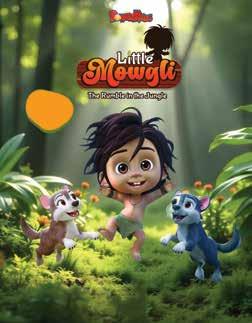

tion partnerships across key territories. By showcasing our strong track record in delivering world-class kids’ content and the success of PowerKids TV, which now reaches over 60 million subscribers all combined and has generated well over 25 billion views globally, we aim to build long-term value-driven collaborations.
Our top three goals at MIPCOM 2025 are
� Expand global distribution and coproduction alliances for our new and existing IPs with major broadcasters and streamers.
� Strengthen licensing and merchandising partnerships to enhance brand visibility and monetization across multiple platforms.
� Showcase the growing PowerKids ecosystem—from our FAST channels and YouTube network to the upcoming B2B OTT platform.
What drove the decision to adapt Indian comic book icons like Supandi and Wingstar into animated series?
I think the decision to adapt beloved Indian comic book icons like Suppandi and WingStar into animated series was driven by the commitment to celebrating India’s rich storytelling heritage while creating globally appealing, culturally rooted content.
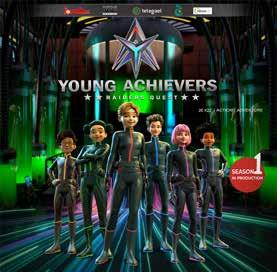
These characters have been an integral part of Indian pop culture for generations, and bringing them to animation allows us to reintroduce them to a new audience in a fresh, dynamic way.
We’re delighted to have a wonderful collaboration with Zebu Animation to bring Suppandi’s hilarious misadventures to PowerKids TV, promising endless laughter and entertainment for our young audience. Suppandi’s journey to 3D animation marks a new chapter in Indian comic history, blending nostalgia with innovation.
How is PowerKids leveraging MIPCOM to strengthen relationships with global broadcasters and OTT platforms for its latest slate of animated content?
MIPCOM provides a unique platform for us to directly engage with key decisionmakers from broadcasters and OTT platforms around the world. For PowerKids, it’s not just about showcasing content— it’s about building meaningful relationships, understanding market trends, and aligning our programming with the evolving needs of international partners.
Through MIPCOM, we are able to present these properties, discuss co-productions, and forge strategic partnerships that strengthen our global footprint and open avenues for distribution, merchandising, and long-term collaborations.
Can you elaborate on how MIPCOM serves as a launchpad for PowerKids’ coproduction initiatives with international partners?
MIPCOM functions as a global incubator for co-production opportunities. It allows us to meet potential partners in person, align creative visions, and establish mutual trust—critical elements for successful international co-productions. For example, with Adventures of Akira & Mowgli, we engaged here with multiple co-producers across different regions, and through our multiple meetings, we have received creative inputs and content strategies.
The event accelerates the conversation from conceptual discussion to actionable deals, enabling us to not only expand our reach but also enhance the production quality and marketability of our IPs through collaborative expertise.
Could you discuss the creative evolution behind major IPs like Adventures of Akira & Mowgli and how they expand the legacy of The Jungle Book franchise for global audiences?
With Adventures of Akira & Mowgli, we are building on a beloved legacy while introducing fresh, compelling narratives for a contemporary audience. Akira’s character brings a strong, relatable female perspective and a sense of responsibility, complementing Mowgli’s iconic journey.
The series preserves the adventurous spirit of The Jungle Book while expanding the universe with new storylines, stunts, and emotional arcs. By focusing on universally resonant themes such as friendship, courage, and curiosity, we ensure the content appeals to both traditional fans and new generations of viewers globally. It is this blend of nostalgia and innovation that strengthens our IP’s global positioning.
There has been a shift in broadcasters’ outlook when it comes to producing content. Many are ready to share IPs and looking for new business models. Absolutely. Broadcasters today are much more collaborative and flexible than before. They recognize that partnering with creative studios and sharing IPs can open up new revenue streams, whether through co-productions, licensing, or merchandising. This shift allows for innovative business models where risk, creativity, and profit are shared, benefiting both the IP holders and the broadcasters. For Power Kids, this trend accelerates our ability to co-create highquality content while ensuring that our stories reach global audiences in ways that are commercially sustainable and creatively enriching.
The success of Mahavatar Narasimha has been remarkable—how has this film influenced Power Kids’ approach to mythological storytelling and faithbased animation?
I feel its success has been a valuable benchmark for the Indian animation industry. It demonstrates that audiences are deeply receptive to mythological and faith-based stories when executed with high-quality animation and compelling narratives.
In what ways did Mahavatar Narasimha’s box office performance and cultural resonance open new opportunities for Indian animated films in global markets?
Recent successes have highlighted Indian animation as a serious contender in the global entertainment market. There’s now a clear opportunity to scale original IP, attract international co-productions, and position culturally rich stories for worldwide audiences.
Are you currently working on any animation films scheduled for release in the next 12–18 months?
Yes, we have some exciting animation projects in the works, and you’ll hear about them soon.
How is the fragmentation of the global distribution landscape affecting Power Kids’ monetization strategies, particularly given the increasing demands for exclusivity from platforms?
The global distribution landscape is highly fragmented, as broadcasters, OTT platforms, and FAST services each seek differentiated content and, in some cases, exclusivity. For PowerKids, this situation necessitates a flexible monetization strategy that balances audience reach with revenue optimization.
We adopt a tiered approach by selecting platforms for exclusive premieres and leveraging multi-platform distribution to maximize IP visibility, audience engagement, and ancillary revenue streams such as licensing, merchandising, and co-productions. This model allows us to protect our content’s value while ensuring it reaches the widest possible audience.
What role do digital platforms, such as YouTube—where PowerKids has amassed over 44 million subscribers— play in your overall business model and in testing intellectual property (IP) before broader distribution?
Our combined subscriber base exceeds 60 million, and YouTube acts as a vital proving ground for our content. YouTube contributes significantly to our revenue and brand-building efforts, creating a loyal fanbase that supports both our original IPs and long-term licensing strategies.
With the launch of dedicated FAST channels on Samsung TV Plus and JioTV, how is Power Kids shaping the future of free ad-supported television for children in India?
The launch of dedicated FAST channels allows us to bring high-quality children’s content directly to viewers without or with very low subscription barriers. This is particularly significant in India, where accessibility is key. By curating engaging programming blocks, we can deliver consistent brand experience, generate targeted ad revenue, and experiment with content formats and scheduling that resonate with young audiences. FAST channels are an important part of our strategy to make premium animation widely accessible while simultaneously testing new monetization models for a growing digital-first generation.
How do partnerships with platforms like Swift TV and RUNN TV contribute to Power Kids’ vision of redefining children’s entertainment accessibility across diverse demographics?
Partnerships with platforms like Swift TV and RUNN TV allow us to reach audiences across varied socio-economic and geographic segments, including regions where traditional pay-TV penetration may be limited. These collaborations enable us to deliver high-quality, locally relevant content in an inclusive and scalable way.
By expanding access, we are not only growing our viewership but also fostering brand loyalty and creating opportunities for IP extensions, merchandising, and long-term engagement across diverse demographics.
Looking ahead, how do you foresee the animation industry evolving, and how is Power Kids preparing to stay at the forefront of technological and creative innovation?
Technological sophistication, crossplatform storytelling, and global IP scalability are increasingly driving the animation industry. We foresee a growing convergence between traditional animation, interactive experiences, and AI-driven content updates.
PowerKids is investing in cutting-edge animation pipelines, VR/AR experiments, and high-fidelity production techniques, while fostering creative excellence in story development. Our goal is to maintain global competitiveness by delivering narratives that resonate culturally yet appeal universally, ensuring our IPs are ready for both traditional and emerging platforms.
THIS YEAR’S MIPCOM MARKS A MAJOR PUSH FOR POWERKIDS TO GROW ITS BRAND INTERNATIONALLY, NURTURE HOMEGROWN TALENT, AND PIONEER NEW STRATEGIES IN LICENSING, MERCHANDISING, AND CONTENT
DISTRIBUTION FOR A DYNAMIC, DIGITALFIRST GENERATION
Filmmaking is on the cusp of a revolution, where AI tools promise both unprecedented access and uncharted risks. As studios and streamers turn to data-driven storytelling, and indie creators harness generative technology, the core question emerges: who will guide the narrative? The next century of cinema may depend less on technical innovation, and more on who holds the reins of imagination itself
By Dr S. Raghunath

Dr S. Raghunath, Professor of Strategy, Indian Institute of Management Bangalore
For more than a century, cinema has been the art form that most faithfully captured the collective human imagination. From the handpainted frames of Georges Méliès to the CGI universe of Marvel, every cinematic revolution has been propelled by technology but also by human dreams.
Now, artificial intelligence is poised to upset this delicate balance. The question is no longer whether AI can make films; it demonstrably can, but whose imagination will guide the stories it tells?
In less than five years, AI has evolved from a post-production assistant to a professional filmmaker. It can write scripts, generate visuals, simulate actors, com-
pose music, and even predict audience reactions before release. Generative video tools such as OpenAI’s Sora, Runway’s Gen-2, and Pika Labs’ real-time animation engines have blurred the line between production and imagination.
Filmmaking required crews of hundreds, but today, a single creator can produce a cinematic short using AI-generated storyboards, voices, and lighting effects indistinguishable from live-action.
This democratization appears liberating. A teenager in Lucknow, Lagos, or Lisbon can now visualize a fantasy epic without a studio or budget. AI lowers the barriers that have long fenced off filmmaking to those with capital and connections.
In theory, this democratized imagination could flourish, creating an internet filled with independent filmmakers. But this seductive promise masks a deeper struggle: the ownership of imagination and its use.
Hollywood, Silicon Valley, and the global streaming giants are already converging to define what AI creativity “should” look like. Warner Bros. uses Cinelytic, an AI analytics engine, to greenlight films based on predicted audience sentiment and profitability.
Cinelytic-style prediction systems represent the triumph of data over daring, a world where cinema becomes a calculated investment rather than an artistic gamble. By mining past performance data, these AI tools guide studios toward “safe bets,” optimizing budgets and casting for maximum predictability.
Yet, films like Kantara and Parasite emerged precisely by defying those predictive conventions. Kantara wove folklore, faith, and local idioms into a visceral cinematic language that no algorithm could have forecasted to resonate globally. Parasite, too, shattered genre norms and cultural barriers, proving that originality can outperform optimized sameness. The contrast is revealing!
AI may secure the balance sheet, but creativity secures the soul of cinema. True progress will come not when algorithms replace instinct, but when they refine it, when prediction becomes a servant to vision, not its master. Only then will technology elevate, rather than eclipse, the art of storytelling.
Netflix’s recommendation algorithms shape what millions watch and increasingly, what gets made. In China, AI censors are now being integrated into scriptwriting tools to automatically flag “politically sensitive” ideas before a project is even pitched.
Thus, AI dictates imagination, a world where stories are no longer authored by artists but engineered by data. Instead of creativity driving technology, technology begins to drive creativity. The danger is
HOLLYWOOD’S PARADOX IS PROFOUND. THE VERY INDUSTRY THAT FEARS AI’S CREATIVE TAKEOVER IS ALSO FINANCING IT. THE ANXIETY IS JUSTIFIED. IF STUDIOS CAN CREATE PERFECT
not dystopian fiction but cultural uniformity, an algorithmic culture where the same emotional arcs, the same beauty norms, and the same moral hierarchies are endlessly replicated because they test well.
When a film’s emotional rhythm is determined by machine-learned patterns from past box-office hits, cinema stops being a mirror of the human condition and becomes a mirror of consumer behavior. The artist’s curiosity yields to the platform’s optimization. The imagination, that last human frontier, becomes a spreadsheet.
Bollywood’s quiet AI revolution dramatizes the global paradox of technology in art. The same tools that democratize creativity also centralize control. On one hand, AI-driven production tools like Runway’s generative video editing, Pika Labs’ visual synthesis, and Cinelytic’s predictive analytics have made it possible for small independent filmmakers to produce sophisticated visuals, enhance VFX, and even previsualize scenes on shoestring budgets.
A filmmaker in Kochi or Bhopal can now use AI-based dubbing to reach multilingual audiences without the prohibitive costs of reshoots or manual synchronization.
Start-ups are already experimenting with script generation, casting analytics, and crowd-testing of edits, enabling a new wave of agile storytelling from the margins.
The same technological arsenal empowers major studios to control narrative ecosystems. They deploy AI not just for
production efficiency but to algorithmically predict viewer emotions, tailor promotions, and even shape storylines for data-proven success.
The risk is subtle but profound. Stories become optimized for engagement rather than meaning. When AI predicts which plot, tone, or actor maximizes “completion rate,” art becomes analytics.
The battle for imagination in India, therefore, is not about who has the better algorithm, but who controls its moral compass.
Will AI remain a tool of inclusion, giving regional filmmakers and underrepresented voices new reach, or will it reinforce the dominance of corporate storytelling that treats imagination as inventory? As AI rewires Bollywood’s creative economy, the contest ahead will be less about machine learning and more about human discernment and the ethics of who decides what stories deserve to be told and why.
Across Europe and the UK, the AI debate is less about technological capability and more about artistic sovereignty. The British Film Institute, the European Audiovisual Observatory, and media unions are actively developing codes of ethics for AI-generated content.
European filmmakers are experimenting with AI-human co-creation, as seen in Here, a UK film using Metaphysic’s
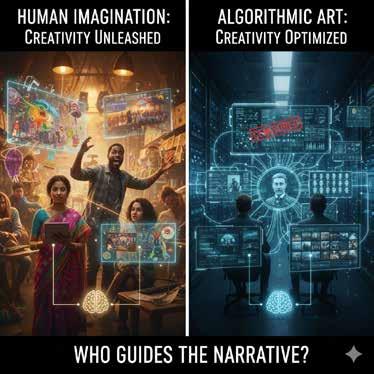
real-time generative de-aging technology. Yet these advances occur within a framework of accountability: directors must disclose AI usage, and performers must consent to digital reproduction.
Europe’s approach to AI in cinema reflects its broader cultural philosophy of art as a social contract, not just a product. Here, imagination is still treated as a public valuable, not a private asset.
The danger is that excessive regulation may slow innovation. But Europe’s caution offers a counterpoint to the corporate hyperdrive of Hollywood and the improvisational focus of Bollywood. There is a belief that creativity can remain both modern and moral.
Nowhere is the AI debate more intense than in Hollywood. The 2023 Writers Guild of America and SAG-AFTRA strikes were not about jobs alone; they were about the ownership of imagination.
Writers demanded guarantees that AI would not replace their work, and actors sought protection from digital replicas of their faces and voices. The resulting contracts established the world’s first consent architecture for AI creativity. Ironically, the same studios that lobbied to use AI freely are now the biggest investors in AI start-ups building synthetic performers and predictive storytelling models.
Hollywood’s paradox is profound. The very industry that fears AI’s creative takeover is also financing it. The anxiety is justified. If studios can create perfect digital actors, write data-driven scripts, and market films algorithmically, where does the human artist fit? Yet to dismiss AI outright is to ignore its creative potential.
When responsibly used, as with The Irishman’s de-aging or Avatar’s AIdriven motion capture, AI enhances cinematic imagination rather than erasing it. The frontier, then, lies not between man and machine, but between control and collaboration.


Ten years on, Netflix India stands as a testament to the universal appeal of Indian stories. As Monika Shergill, Vice President of Content, Netflix India, looks ahead, she believes the next wave of storytellers will unite audiences everywhere, blending authenticity with global resonance.
As Netflix India celebrates a decade of transformative storytelling, Monika Shergill, Vice President of Content, Netflix India, reflects on a journey that has not only redefined Indian entertainment but also propelled its stories onto the global stage. In an address at the 25th edition of FICCI FRAMES in Mumbai, Monika Shergill offered a compelling look at how Netflix has become a catalyst for Indian stories to be created, consumed, and celebrated worldwide—ushering in what she describes as the “Netflix Effect.”
Monika Shergill’s journey from journalist to filmmaker, and ultimately to a leading content executive, has been shaped by an enduring curiosity about people and their stories. “Every story, every issue, is about the people behind it,” she observed, recalling her fascination with journalism as a schoolgirl watching black-and-white television. The desire to create stories that “last longer and touch deep-
REGIONAL CINEMA TODAY IS NOT JUST NATIONAL—IT’S INTERNATIONAL, AS NETFLIX
er” led her to entertainment, where she continues to approach content through the lens of character, society, and emotional truth.
She underscored that Netflix’s evolution over the past decade has been audience-led, with Indian viewers’ appetite for entertainment continually inspiring creators to reach new heights. “This 10-year journey is really about the audiences in India. Their love for entertainment gives rise to storytellers and gives everything we do meaning, not just here but across the world,” Monika Shergill shared during a fireside chat with RJ HrishiKay at FICCI FRAMES.
Netflix’s impact in India is best illustrated by its power to turn local stories into international sensations. Monika Shergill pointed to several inflection points: the global success of Sacred Games, the International Emmy wins for Delhi Crime and Vidya Balan’s Sherni, and the Oscar triumph of The Elephant Whisperers. She also highlighted the spectacular journey of RRR, which captured audiences worldwide, and a new wave of hits like Heeramandi, Saiyaara,
and The Ba*ds of Bollywood*—titles that exemplify the “Netflix Effect,” where stories transcend the screen to become part of everyday conversation, culture, and fashion.
Reflecting on these turning points, Monika Shergill noted, “Every inflection point is built on countless milestones,” emphasizing that the combination of bold storytelling, creative risk-taking, and local authenticity has enabled Indian content to travel further than ever before.
Monika Shergill challenged the notion that only “prestige” projects matter, arguing instead for a more expansive view of quality. Streaming, she said, democratizes storytelling by giving viewers immense choice and allowing creators to reach audiences at scale. “Earlier, people watched whatever was given to them. Streaming changed that. Today, audiences pull stories toward them. The greatest ones are deeply crafted and widely loved,” she explained, emphasizing that authenticity and craftsmanship can go hand in hand with mass appeal.




















“THE NETFLIX EFFECT” IS ABOUT MORE THAN STREAMING—IT’S ABOUT INDIAN STORIES SHAPING CULTURE, SPARKING CONVERSATIONS, AND INSPIRING CREATIVITY FAR BEYOND BORDERS, THANKS TO A DECADE OF VISIONARY LEADERSHIP
For Monika Shergill, cultural impact goes far beyond viewing figures. She described the “Netflix Effect”—when a show or film transcends the screen and becomes part of everyday conversation, spawns memes and social trends, or launches breakout stars. “When you hear a story in cafés, homes, or memes, that’s The Netflix Effect,” she said, citing the example of Heeramandi influencing fashion and music, and the viral popularity of Netflix’s musical content.
Notably, she pointed to the success of Amar Singh Chamkila, which challenged industry notions that “songs don’t work on streaming,” paving the way for musical storytelling in Indian and global hits alike.
Monika Shergill celebrated the rise of regional cinema and its journey from local to global, underscoring a powerful new reality: “Regional cinema today is not just national—it’s international.” Netflix India subtitles content in 37 languages, and over 70% of viewing globally happens through subtitles or dubbing. The platform actively supports smaller, hyper-local films alongside blockbusters, ensuring that gems from across India—regardless of language—are discovered by audiences worldwide. “Stories are becoming language agnostic,” she affirmed, “and more people have the ability to enjoy them.”
Recognizing that the future depends on fresh, diverse voices, Monika Shergill described Netflix’s creative ecosystem, which includes programs
like Grow Creative and the NFDC 100 Women Screenplay initiative. These mentorship and training efforts are designed to develop original writers, directors, and technicians from across India, particularly from its heartlands. However, she urged the wider industry to do more, emphasizing that the real power to nurture talent lies with producers and studios beyond Netflix.
Every project involves risk, Monika Shergill admitted, but some surprises stand out. She cited Chandramukhi as a bold, experimental film that exceeded expectations and went on to receive international acclaim. Similarly, Mismatched—a coming-of-age series—defied assumptions about what would succeed on the platform, highlighting the unpredictable magic of creative risk-taking.
Looking to the future, Monika Shergill expressed optimism despite the challenges posed by rapid technological change. She believes that while the world may be divided in many ways, stories will always unite us. “Streaming has made it possible for creators to be both bold and universal. When a filmmaker’s passion reaches more people—not fewer—that’s the highest form of entertainment,” she said. With India’s media and entertainment sector projected to grow rapidly, Monika Shergill sees streaming becoming even more accessible and integral to daily life.
As Netflix India enters its second decade, Monika Shergill’s vision is clear: to keep championing diverse stories, nurturing new voices, and ensuring that Indian content continues to resonate both at home and around the world.
WITH OVER 70% OF GLOBAL VIEWING ON SUBTITLES AND DUBS, NETFLIX INDIA IS BREAKING LANGUAGE BARRIERS AND PROVING THAT POWERFUL STORIES RESONATE UNIVERSALLY—NO MATTER WHERE THEY BEGIN
In this post-truth era, the responsibility of journalism is more vital than ever. As technology transforms how stories are told and consumed, the fight for factual, credible reporting isn’t just about survival—it’s about safeguarding the very foundation of democracy and public trust, says Aroon Purie, Founder, Chairman, and Editor-inChief of the India Today Group
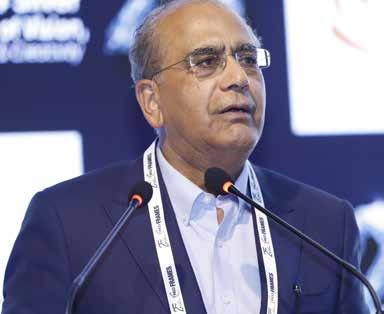
Aroon Purie Founder, Chairman, and Editor-in-Chief of the India Today Group
Fifty years ago, a young Aroon Purie launched India Today in a world where print was king and news traveled at the speed of a printing press. Fast forward to today, and Purie presides over a media empire that spans 24-hour television, digital platforms, mobile apps, and even India’s first AI news anchor, Sana. The multimedia juggernaut reaches nearly three-quarters of a billion people. Yet after half a century in the business, Purie’s outlook is anything but complacent.
If longevity has taught him anything, it’s that survival in this business is a high-wire act, forever balancing on the next big disruption. “If there is one lesson I have learned over the past five decades, it is this: disruption never ends. In fact, disruption is the only constant,” he told a gathering of the minds shaping India’s media and entertainment landscape at the 25th anniversary edition of FICCI FRAMES.
This was not the nostalgia of a veteran looking back, but a clear-eyed diagnosis of a sector where the ground keeps shifting. From the “miracle” of India’s world-leading media volume to the existential threats posed by algorithms and AI, Purie’s address was both a chronicle of innovation and a candid warning: the future of credible journalism—and democracy itself—may hinge on how boldly the industry reinvents itself now.
India’s media industry defies global comparison—not just in scale, but in sheer exuberance. “In terms of sheer volume, we are the undisputed global king of news media,” Purie declared, marveling at the staggering numbers: over 140,000 registered publications, nearly 900 satellite TV channels, with more than 375 devoted entirely to news. “Just the city of Delhi wakes up to dozens of English newspapers daily, and just as many regional newspapers. I’m sure no city in the world has that.”
It’s a gigantic industry. But, Purie asked, “Have you stopped to think who really pays for it?”
Much of India’s media, he noted, runs on what he wryly called “rugby economics”—papers so cheap that “at the end of the week, you get more for it than you actually paid for it when the radi wala comes to collect it.” It’s a paradox: “Perhaps this is the only product in the world where the consumer stops consuming but the supply keeps continuing.”
Broadcasting, too, suffers from market distortions. Cable TV channels, he explained, still pay carriage fees just to reach viewers, a practice intended for a bygone era of limited bandwidth.
“It is beyond my understanding why the government treats the supply of cable TV as an essential commodity whose price they must regulate like wheat or rice,” Purie said, his frustration palpable. “The regulations are strangling the broadcasting industry, which provides employment for over 1.7 million people… To my mind, the government has made a mess of the broadcasting industry due to lack of foresight and regressive policy.”
At the heart of the problem lies an uncomfortable truth: “The bottom line is that news is, by and large, cheap or free for the consumer, and the publisher or the broadcaster gets very little of what the consumer pays,” Purie observed. “So who really pays for the gigantic news industry?” The answer: advertisers. “When journalism’s survival depends almost entirely on advertising from corporations and governments, its independence is under a constant threat of compromise. The hand that gives can also take away.”
He was quick to point out that, despite the constraints, “the advertising funding model has, against all odds, produced some of the finest journalism in India”—from the exposure of the 2G spectrum scam to the coverage of the COVID-19 pandemic and the Ukraine war. But the space for dissent, he warns, “is shrinking, not because of jackbooted censor, but because of balance sheets and ad sales targets.”
Today, the stakes have risen with the arrival of “billionaire news channels.” Large industrial houses, Purie noted, are entering the business “for whom news is not a business at all, but it is a tool of influence and access. They are destroying the economic models of the news channels, which will be detrimental, not just to profitability, but to good journalism.” The corrosive result? “The public believes that every channel is a mouthpiece for vested interests.”
When the news business moved online, it seemed a chance to rewrite the rules. “Digital news was our chance to fix the model, to build
a direct relationship with the reader,” Purie recalled. “But we repeated the same mistake, only this time on a global scale. We gave our product away for free, chasing scale and eyeballs.”
Instead of editors and publishers, “Google, Facebook, YouTube, and Twitter became the world’s new editors-in-chief. They produce no journalism, but they control its distribution and monetization.” The consequences, Purie said, are maddening: “They are the real media companies of this country, with over 70% of total media revenue. They’re eating the breakfast, lunch, and dinner of media companies, leaving only crumbs for publishers and broadcasters.”
Worse still, the very nature of news has changed. “The algorithm doesn’t reward depth, accuracy or nuance. It rewards outrage, speed and virality. It has transformed our information ecosystem into a battleground for attention, contaminating public discourse in the process. Newsrooms that once invested in reporters now have to invest in SEO specialists.”
Just as the industry grapples with the dominance of digital gatekeepers, a new wave looms: artificial intelligence. “AI is being positioned as a new arbiter of truth. It can summarize five articles into one paragraph. It can give you an answer directly so you never have to click. But what happens to the original news organizations, the ones who pay reporters and fight court cases to bring you the news?” Purie asked, voicing an anxiety shared by many traditional media leaders.
This, he argued, is “an existential threat to the very creation of credible information. Content is scraped, synthesized, and regurgitated without credit or revenue.” It’s a future in which the hard work of journalism risks being
devalued—and potentially erased—from the information ecosystem.
Despite a half-century of disruptions, Purie’s message isn’t one of resignation but of resolve. “We as an industry must stop apologizing for the value of what we create. We must innovate, not just in our content, but in our business models. We must persuade our audience that credible, well-researched news is a public good. Like any public good, it has a price. It cannot be free.”
For Purie, subscriptions aren’t just a revenue stream—they’re “a vote for the kind of media you want to exist.” The challenge, he said, “is not just to survive the next wave of disruption, but to build a future where our journalism is just not viable but valuable.”
“The real question is, do we have the courage, imagination, innovation, resilience and integrity to seize it? The challenge today is not just to survive the next wave of disruption, but to build a future where our journalism is just not viable but valuable. In an era of post-truth, telling the truth matters even more. The future of truth in India, and indeed the health of our democracy, depends on it,” he said.

Reflecting on KBC, IPL, and Baahubali as milestones, Gaurav Banerjee, Managing Director and CEO of Sony Pictures Networks India, underscores a tenyear innovation gap. His message: India’s creative sector must seize this moment, daring to deliver the next era-defining leap for audiences at home and worldwide
Amidst the hustle and energy of the 25th FICCI FRAMES in Mumbai, Gaurav Banerjee, Managing Director and CEO of Sony Pictures Networks India, took the stage with a message that was both urgent and visionary. “The topic for today is regulating the orange economy—or the creator of the universe,” he began, acknowledging that while the question of creative regulation isn’t new, it is now more central than ever before.
India’s media and entertainment sector, Gaurav Banerjee revealed, is currently valued at nearly $30 billion, contributing about 7% to the nation’s GDP and growing at a robust 7–8% annually. But there’s a catch: “Nearly all of this is just domestic demand,” he pointed out. The pressing question, then, is clear—what will it take for India’s creative industries to break out globally and scale up like never before?
Gaurav Banerjee posed two provocations for the future: “What is stopping us from birthing an at-scale, content phenomenon—the ‘IPL’ of entertainment, something global in ambition and deeply rooted in Indian stories? And how do we build an institutional framework to scale private investment in content, the way we did in pharma or IT?” His vision was bold: a Silicon Valley of creativity in India.
Reflecting on the last 25 years, Gaurav Banerjee highlighted three inflection points in Indian content: the launch of KBC (Kaun Banega Crorepati) with a Bollywood superstar at its helm, the game-changing arrival of the IPL, and the rise of pan-Indian television and films like “Baahubali.” Yet, he observed, “The last of these big innovations happened ten years ago. For the last decade, we’ve been waiting for the next big leap.”
So, why the wait? And how can change accelerate? Gaurav Banerjee believes the answer lies in human capital. Citing Enrico Moretti’s “The New Geography of Jobs,” he argued that prosperity is increasingly determined by regions that attract and retain skilled workers, research, and innovation. He pointed to the IPL as a model—a league that systematically scouts, nurtures, and invests in talent, creating a world-class pipeline.
“This is the kind of ecosystem we need,” Gaurav Banerjee said. “An ecosystem that reaches the most rooted, most authentic storytellers and enables them to craft stories good enough for the world.” With India’s vast and vibrant cultural reservoir, he insisted, “our films, our music, and our digital creators should be watched, shared, and celebrated globally.”
Gaurav Banerjee spotlighted the Malayalam film industry as a living example, calling attention to the recent blockbuster “Loka Chapter One.” Made for less than ₹30 crore, it had already grossed over ₹300 crore—a testament to what’s possible when creativity is supported by a strong ecosystem. “Every year, there are at least two or three such films building up,” he said. “Loka is just one more chapter in the evolution of a great ecosystem.”
To scale this success, Gaurav Banerjee laid out a roadmap:
� Build creative institutions and centers of excellence that actively nurture talent through recruitment, scouting, and training.
� Foster close collaboration between academia and industry so that innovation flows seamlessly from research to production.
� Rethink regulation, making it enabling, not restrictive. “Globally, new tech is often allowed to flourish with a light touch. Creativity, paradoxically, is often over-regulated.”
At the heart of Gaurav Banerjee’s message was a call to modernize. “Why is the regulatory framework still anchored in a colonial past?” he asked. “Creative industries are no longer peripheral—they need to be central. They generate jobs, fuel innovation, export identity, and amplify India’s soft power.”
His rallying cry was clear: “If India is to rise in the next chapter of global leadership, we must rely on creativity and technology, investing in creativity with the same boldness and vision that we invest in new technologies.”
Gaurav Banerjee invited policymakers, leaders, and creators to champion this agenda, to push for reform, and to “think truly global in ambition.” For India’s creative economy to fulfill its promise, he insisted, “let it stand at the very heart of our growth story.”

TRADE CENTER 5TH - 7 TH NOV 2025


As the curtain closes on one era and another begins to take shape, Siddharth Roy Kapur’s message is clear: Embrace the unknown, keep creating, and trust that great stories will always find their way
When Siddharth Roy Kapur, Founder and Managing Director of Roy Kapur Films, took the stage at the 25th FICCI FRAMES in Mumbai, he did something unexpected. Instead of diving straight into the popular topics of platform shifts and new creative frontiers, he invited his audience to take a step back. To look not just at the next quarter or year, but at the broader horizon.
“We don’t often get the chance to zoom out and look at things from a longer-term perspective,” he said, opening his keynote address with a call for reflection amidst what he described as “uncharted waters.”
“The very topic gives you a sense that there’s a little bit of a sense in our industry… that we’re in uncharted waters. Platforms are changing. The distribution models are changing. The audience is changing. This new technology—AI—is coming in, which we now know that we are not going to be fully capable of handling and having enough control. It will grow in ways that we have no idea about.”
Siddharth Roy Kapur, known for backing some of India’s most celebrated films, acknowledged the palpable sense of flux running through the industry. Borrowing a framework from an unlikely source, former US Secretary of Defense Donald Rumsfeld, Siddharth Roy Kapur divided the challenges ahead into “known knowns, known unknowns, and unknown
WE ARE LIVING THROUGH PLATFORM SHIFTS AND TECHNOLOGICAL LEAPS, BUT I BELIEVE AUTHENTICITY AND ORIGINALITY WILL ALWAYS SET US APART IN A CROWDED DIGITAL WORLD
unknowns.” It is, he said, the last category—the surprises we can’t possibly anticipate—that have always shaped the fate of countries and industries alike.
Yet, even in times of flux, some things are certain. Siddharth Roy Kapur pointed out that digital has become central to the way Indians consume content. The AVOD model, where advertising revenue drives the industry, has become the norm here, in sharp contrast to the subscription-first approach of many Western markets.
As digital leaps forward, so too does regionalization, with powerful creative and business ecosystems thriving not just in the South, but across India’s varied
linguistic and cultural landscape. Each region has found its own unique voice, even as global giants test their reach across state and language lines.
“Today, at least in India, you’ve got very, very strong regional markets that have business models unto themselves, a creative ecosystem that is completely unique to them… despite the fact that now you’ve got large global players coming in,” he explained.
The digital revolution has brought with it a new reality: audiences are now fragmented, living inside their own algorithm-driven echo chambers. “We are all living in parallel content universes,” Siddharth Roy Kapur mused, noting how even close friends will have wildly different social media feeds, each tailored by invisible hands to their unique preferences. This hyper-personalization means that content creators can no longer rely on one-size-fits-all formulas.
Despite predictions of its demise, the theatrical experience has proven resilient. Recent blockbusters and even foreign hits have brought audiences back to cinemas, reminding the industry that when the story is strong—and the experience is unique— audiences are willing to pay for it. Streaming, meanwhile, has become dominant on a global scale, even as Indian viewers continue to split their time between OTT and traditional TV in a hybrid viewing model.
But even as screens multiply, people crave live, communal experiences more than ever. Concerts, plays, and sporting events are booming, driven by a desire for genuine human connection in an increasingly digital world. Ironically, as content becomes more abundant and accessible, it is also more disposable. “We flirt with content now,” Siddharth Roy Kapur said, “rarely committing, always ready to move on to the next thing.” This devaluation challenges creators to make each release truly stand out.
Global crossovers are at an all-time high, with international sensations like “Squid Game” and “Parasite” breaking barriers and inspiring hope that Indian stories too will soon find massive global audiences. At the same time, industry consolidation means that a shrinking number of companies control access to audiences, even as millions of individuals find their voice as content creators on platforms like YouTube and Instagram.
And if there’s one new rule, it’s that creators must tread carefully. Political and cultural sensitivities are heightened, with scrutiny coming from all directions. The industry must be more aware and considerate than ever before.
Yet, for all that we know, there’s even more we don’t. The advance of artificial intelligence is certain, but the ways in which it will change content creation—and how audiences will respond—remain unknown. Will viewers value authenticity over machine-made perfection? Will governments step in with regulations that have real teeth, or has the moment for meaningful intervention already passed? Questions about which formats will survive, whether Indian viewers will start paying for content, and how much the eSports market will grow are all up in the air. And what of the future role of India and other emerging markets as creative powerhouses on the global stage?
Then, there are the true unknowns—the possibilities we haven’t even imagined yet. Streaming itself was unthinkable just a decade ago; what if the next transformation is something even more radical, like neural or sensory storytelling? Could there be a backlash against technology, a sudden craving for the real and the tangible, or a collapse of platforms that seem unassailable today?
Faced with such uncertainty, Siddharth Roy Kapur offered grounded advice. The industry, he argued, must double down on what it does best: telling great stories, regardless of the format. Quality content, he insisted, is the common thread that unites viral hits across media. Rather than fearing AI, creators should find ways to use it to their advantage— cutting costs, improving efficiency, but never sacrificing authenticity. Where regulation is lacking, self-regulation must fill the gap. Building a deeper understanding of audiences—who are no longer monolithic groups but collections of micro-cultures— is essential. And as technology advances, protecting intellectual property becomes more important than ever.
In closing, Siddharth Roy Kapur invoked the wisdom of legendary screenwriter William Goldman: “Nobody really knows anything.” In a world of shifting ground and constant change, humility and adaptability are perhaps the industry’s greatest strengths. If creators focus on what they do best, audiences will follow.























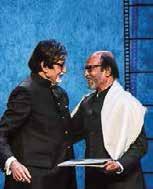














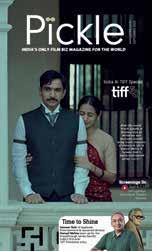






Email : pickle@pickle.co.in Web: www.pickle.co.in











